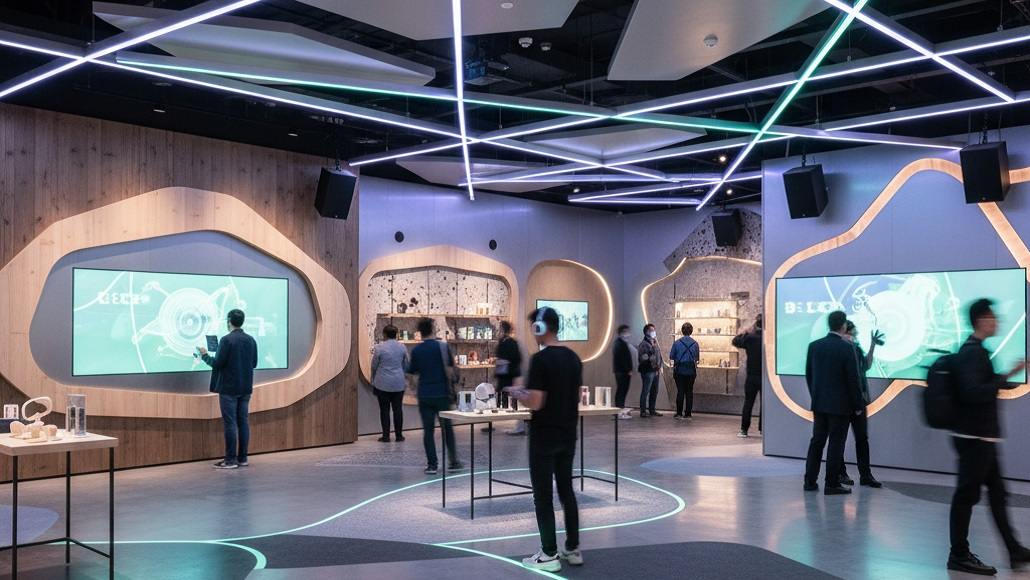The Rise of Multisensory Environments in Commercial Spaces
The evolution of commercial space design has transcended traditional single-sensory approaches to embrace comprehensive environmental strategies that engage multiple human senses simultaneously. Multisensory lighting commercial spaces applications represent sophisticated design integration where illumination works in harmony with sound, texture, scent, and spatial organization to create immersive experiences that influence customer behavior, enhance brand identity, and support business objectives through comprehensive sensory engagement.
Understanding Multisensory Perception in Commercial Environments
 Human perception operates through complex interactions between different sensory inputs that combine to create unified environmental experiences. Commercial spaces that understand and leverage these interactions can create more compelling, memorable, and effective environments that influence customer behavior while supporting business objectives through carefully orchestrated sensory engagement strategies.
Human perception operates through complex interactions between different sensory inputs that combine to create unified environmental experiences. Commercial spaces that understand and leverage these interactions can create more compelling, memorable, and effective environments that influence customer behavior while supporting business objectives through carefully orchestrated sensory engagement strategies.
The psychological impact of coordinated multisensory design extends beyond simple aesthetic appeal to influence emotional responses, memory formation, and behavioral patterns that directly affect customer satisfaction, dwell time, and purchase decisions. Research demonstrates that environments engaging multiple senses create stronger emotional connections and more memorable experiences compared to spaces that rely on visual elements alone.
Multisensory lighting commercial spaces applications must consider how different sensory elements interact and potentially conflict with each other, requiring careful coordination to ensure that combined effects enhance rather than overwhelm the intended user experience. This coordination requires understanding of how light affects color perception, material appearance, and spatial acoustics in ways that can either support or undermine other sensory design elements.
Lighting and Acoustic Integration Strategies
The relationship between lighting and sound in commercial environments represents one of the most sophisticated applications of multisensory design, where illumination systems are coordinated with acoustic elements to create unified atmospheric experiences that support specific behavioral and emotional responses from visitors and customers.
Dynamic lighting systems that respond to music and ambient sound create environments that feel alive and responsive while supporting brand identity through coordinated audio-visual experiences. These systems require sophisticated control integration that synchronizes lighting changes with musical elements while maintaining appropriate base illumination levels for safety and functional requirements.
Acoustic considerations significantly influence lighting design decisions, as hard surfaces that provide excellent light reflection characteristics may create undesirable acoustic conditions, while sound-absorbing materials may affect light distribution and quality. Successful multisensory lighting commercial spaces balance these competing requirements through integrated design approaches that optimize both acoustic and lighting performance.
Material and Texture Coordination with Illumination
The interaction between lighting and material surfaces creates opportunities for sophisticated sensory experiences where illumination reveals and enhances textural qualities while creating visual and tactile contrasts that engage multiple senses simultaneously. These interactions require careful consideration of how different materials respond to various lighting conditions and color temperatures.
Natural materials including wood, stone, and fabric provide rich textural experiences that are dramatically enhanced or diminished by lighting design decisions. Warm color temperatures typically enhance the natural qualities of these materials while cool lighting can create more contemporary, clinical impressions that may or may not align with intended design objectives.
Reflective and metallic surfaces create dynamic interactions with lighting systems that change dramatically based on viewing angles and illumination intensity. These materials can create exciting visual effects while potentially causing glare problems that compromise user comfort, requiring careful balance between dramatic visual impact and practical usability considerations.
Scent and Lighting Coordination for Brand Experience
The coordination of lighting with scent distribution systems creates opportunities for comprehensive brand experiences that engage multiple senses while creating memorable associations that extend beyond immediate visual impressions. These coordinated approaches require sophisticated environmental control systems that manage both lighting and air quality elements seamlessly.
Color temperature and intensity significantly affect how people perceive scents, with warmer lighting typically enhancing perception of warm, comfortable scents while cooler lighting may complement fresh, clean fragrances. Understanding these interactions enables more effective multisensory design that creates coherent environmental experiences rather than competing sensory elements.
Zonal coordination between lighting and scent distribution enables different areas within commercial spaces to have distinct sensory characteristics while maintaining overall design coherence. These approaches support wayfinding objectives while creating varied experiences that encourage exploration and extended engagement with commercial environments.
Retail Environment Applications and Customer Journey Design
Retail environments demonstrate sophisticated applications of multisensory lighting commercial spaces design where illumination coordinates with music, materials, and spatial organization to guide customer movement while creating emotional connections to products and brands. These applications require detailed understanding of customer behavior patterns and shopping psychology.
Product presentation areas benefit from coordinated lighting and acoustic design that creates focus while minimizing distractions that might interfere with purchase decision-making processes. Higher illumination levels and reduced acoustic complexity in these zones support detailed product examination while coordinated background elements maintain overall environmental quality.
Circulation areas and transition zones use different multisensory strategies that encourage movement while maintaining engagement with the overall retail environment. These areas often feature dynamic lighting and varied acoustic elements that create interest while guiding customers toward featured merchandise or specific store areas.
Hospitality and Entertainment Venue Integration
Restaurants, bars, and entertainment venues showcase advanced multisensory lighting commercial spaces applications where environmental design directly influences customer satisfaction, dwell time, and revenue generation through carefully orchestrated sensory experiences that support specific business objectives and brand positioning strategies.
Dining environments require particularly sophisticated coordination between lighting, acoustics, and material selection that creates intimate, comfortable conditions while maintaining adequate illumination for food presentation and social interaction. These requirements often conflict with each other, requiring creative solutions that balance competing objectives through integrated design approaches.
Entertainment venues including theaters, concert halls, and nightclubs use multisensory design to create immersive experiences where lighting coordinates with sound systems and architectural elements to transport visitors into carefully constructed experiential environments that support specific entertainment objectives and audience engagement goals.
Workplace Environment Applications and Productivity Enhancement
Commercial workplace environments increasingly apply multisensory design principles to support employee productivity, satisfaction, and wellbeing through environmental conditions that address multiple human needs simultaneously while maintaining functionality required for diverse work activities and collaboration requirements.
Open office environments benefit from multisensory approaches that use lighting, acoustic elements, and material selection to create varied zones that support different work styles while maintaining overall environmental quality and visual coherence. These approaches help address common open office challenges including noise distraction and lack of privacy without requiring extensive physical barriers.
Meeting and collaboration spaces require multisensory design that supports communication while minimizing distractions that might interfere with productive discussion and decision-making processes. Coordinated lighting and acoustic design in these spaces enhances speech intelligibility while creating comfortable conditions for extended meeting periods.
Technology Integration and Dynamic Control Systems
Advanced building management systems enable sophisticated coordination between lighting, audio, and environmental control systems that create responsive multisensory environments capable of adapting to changing needs, occupancy patterns, and programmed experiential sequences throughout daily operational cycles.
Sensor technologies including occupancy detection, audio level monitoring, and environmental quality measurement enable automatic adjustment of multisensory elements based on real-time conditions while maintaining appropriate environmental quality and user comfort throughout varying operational conditions and usage patterns.
Mobile applications and user interfaces provide occupants with control over multisensory environmental elements while maintaining coordination between different systems that ensures overall environmental quality and prevents conflicting adjustments that might compromise the intended user experience or system performance.
Health and Wellbeing Considerations in Multisensory Design
The health implications of multisensory commercial environments require careful attention to avoid sensory overload while creating engaging experiences that support rather than compromise user wellbeing. These considerations are particularly important for environments that serve diverse user groups with varying sensitivities and preferences.
Circadian lighting integration within multisensory environments supports natural biological rhythms while maintaining coordination with other environmental elements that collectively influence occupant health, comfort, and performance throughout extended exposure periods in commercial spaces.
Accessibility considerations in multisensory design ensure that environmental elements serve users with different sensory capabilities while maintaining overall design integrity and effectiveness. Universal design principles applied to multisensory environments create inclusive spaces that provide positive experiences for diverse user populations.
Cultural and Contextual Sensitivity in Multisensory Applications
Cultural considerations significantly influence how multisensory environments are perceived and experienced, requiring design approaches that acknowledge local preferences, traditions, and sensitivities while achieving intended business and experiential objectives through appropriate sensory engagement strategies.
Regional climate and cultural factors affect preferences for color temperature, acoustic levels, and material selections that influence the success of multisensory design approaches. Understanding these regional variations enables more effective design that resonates positively with local user populations while supporting business objectives.
Demographic considerations including age, lifestyle preferences, and cultural background significantly influence how people respond to multisensory environments, requiring design approaches that acknowledge these differences while creating broadly appealing spaces that serve diverse customer and user populations effectively.
Economic Impact and Business Performance Measurement
The business case for multisensory lighting commercial spaces design requires quantifiable performance metrics that demonstrate return on investment through improved customer satisfaction, increased sales, enhanced brand perception, and operational efficiency gains that justify additional design complexity and system costs.
Customer behavior analysis including dwell time, purchase patterns, and satisfaction surveys provides data that supports investment in multisensory design while identifying optimization opportunities that can enhance both user experience and business performance throughout operational periods.
Energy consumption and operational cost considerations must balance enhanced environmental control requirements with efficiency objectives while ensuring that multisensory systems provide net positive economic benefits throughout their operational lifecycle.
Innovation and Future Development Opportunities
Emerging technologies including virtual and augmented reality integration, advanced sensor systems, and artificial intelligence applications promise even more sophisticated multisensory environment capabilities that can respond to individual preferences while maintaining overall environmental quality and business objective support.
Biometric monitoring and real-time physiological feedback systems may enable multisensory environments that adjust automatically to optimize user comfort and engagement while providing unprecedented insight into how environmental design affects human health, comfort, and performance in commercial settings.
Internet of Things integration and machine learning applications will likely enable multisensory systems that learn from user behavior patterns while optimizing environmental conditions automatically to maximize both user satisfaction and business performance through intelligent environmental management that requires minimal conscious intervention from facility operators.
The advancement of multisensory lighting commercial spaces design represents a fundamental evolution in how commercial environments serve human needs while supporting business objectives. The most successful implementations will be those that balance technological sophistication with deep understanding of human psychology, cultural sensitivity, and practical operational requirements while demonstrating measurable benefits that justify investment in comprehensive environmental design approaches.































